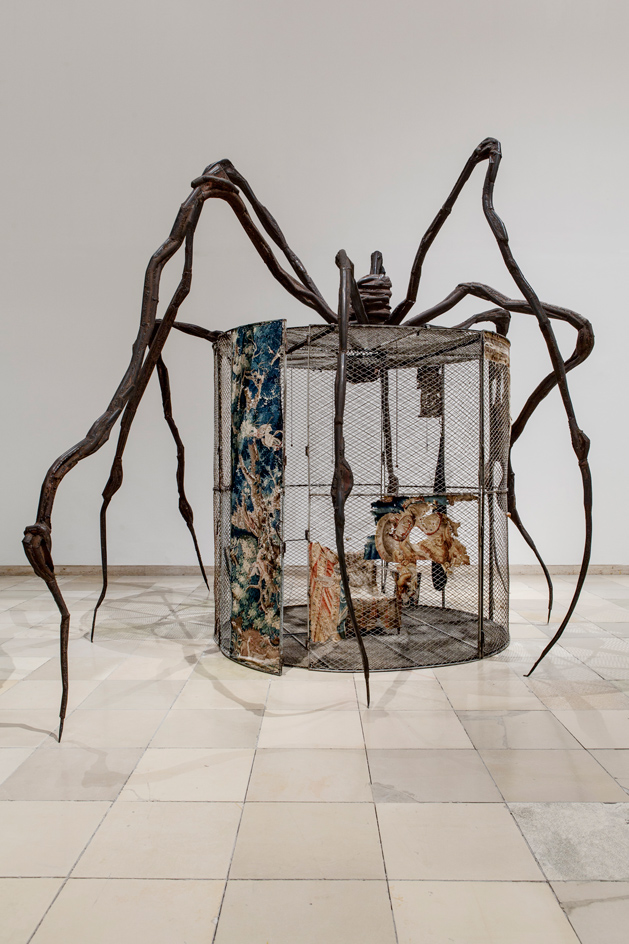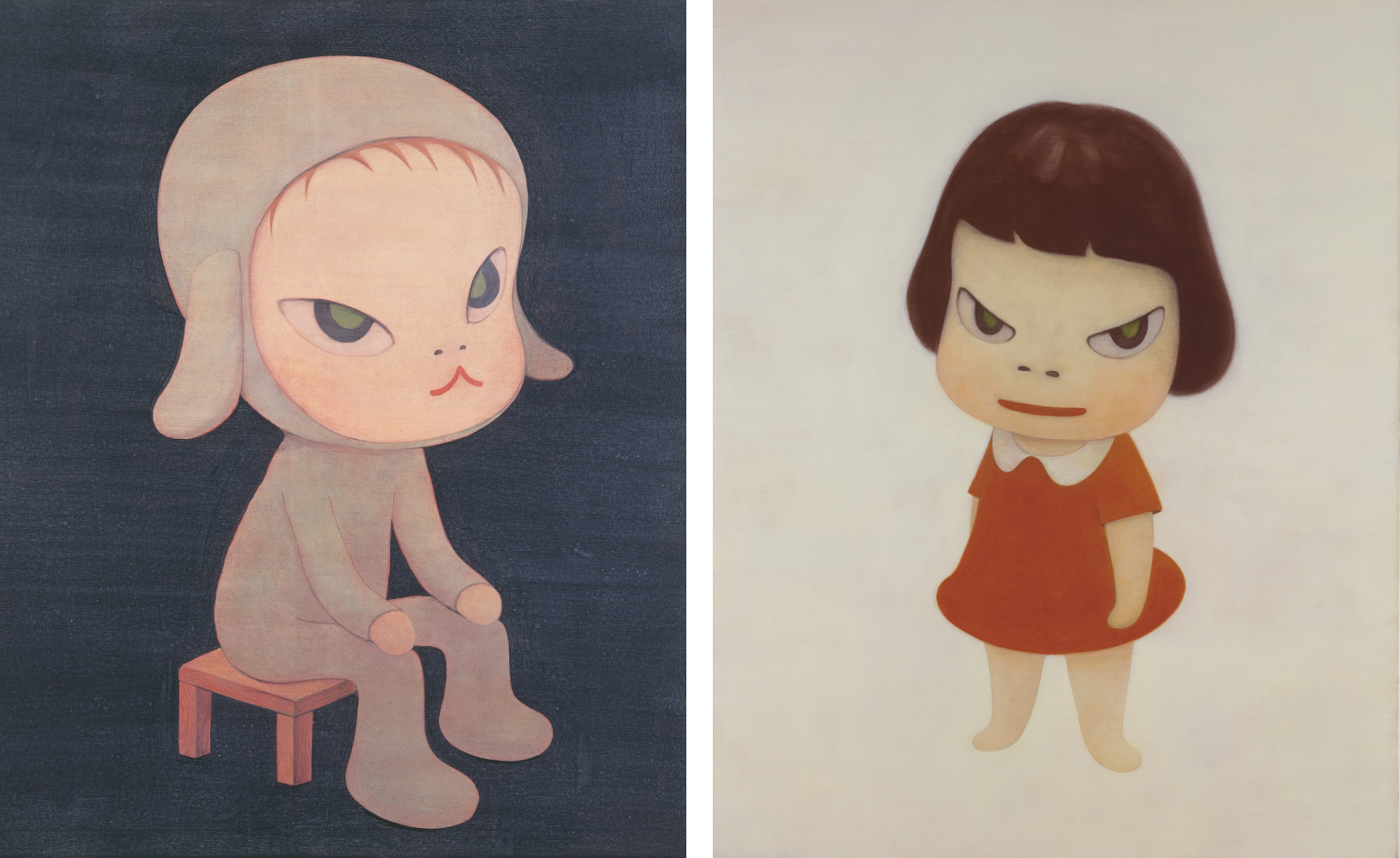Both prison and refuge: Louise Bourgeois’ Cells at the Guggenheim, Bilbao

Louise Bourgois was 97 when she made the last of her Cell works in 2008, two years before she died.
In Cell (The Last Climb), an open door leads into a rusty wire cage. It’s not a prison but a gateway; inside, a spiral staircase leads up and out of the cage to the sky, and large blue glass balls are suspended like bubbles waiting to float free. At the centre of the cage is a brilliant blue rubber droplet like a giant tear – not falling but buoyed by this sense of floaty lightness – which Bourgeois described as a self-portrait.
For an artist who said she made art as a means of survival and a way of confronting fear, this work, a clear metaphor for death, is remarkably uplifting. It’s not fraught with anxiety, in the way that her works that typically explore unconscious emotions surrounding childhood memories, growing up, sex and motherhood are. Bourgeois worked tirelessly through her 70s, 80s and 90s with an urgent combative energy that one can only marvel at here. Perhaps by 2008 she was finally ready to let go.
Bourgeois created 60 Cells. Of the 28 on display at the Guggenheim Bilbao, most were created in the last two decades of her life. Each Cell is a world; a stage set to either be contained in, journeyed through, peeked voyeuristically into, or be excluded from.
They are precise, contained, and complete spaces, featuring sculpture and objects that Bourgeois owned or gathered to tell autobiographical stories. Some are more literally based on memories than others. One draws on a memory of her parents' bedroom, another features a marble replica of her childhood home with a guillotine poised above it, anticipating a moment when it might all disappear.
Frank Gehry’s gallery interior, a seemingly endless maze of rooms and corridors that curve and twist, grow and shrink, is an invitation to get lost. That suits Bourgeois’ work down to the ground, because it’s never about what's outside, but always the warped, shape-shifting unpredictability of her interior world.
Like a spider’s web, this world is a place of seductive, horrible beauty. Inevitably you are drawn into it, and as you are you begin to see that the unconscious world she was exploring has its own own internal logic. Repeating symbols – mirrors (confrontation of the self), doors (secrets and safety), limbs (impotence), spiders (the mother) – become a language, which help you to interpret her reality. Eventually a bigger picture emerges. The show, like the body itself, is a place of trauma and escapism, fear and magic: both prison and refuge.

In Cell (The Last Climb) (pictured), an open door leads into a rusty wire cage. It’s not a prison but a gateway – this work, a clear metaphor for death, is surprisingly uplifting. Pictured: Cell (The Last Climb), 2008. Courtesy Collection National Gallery of Canada and The Easton Foundation / VEGAP, Madrid

Bourgeois worked tirelessly through her 70s, 80s and 90s with an urgent combative energy that one can only marvel at here. Pictured: Louise Bourgeois inside (Articulated Lair), which she considered the first of her Cells, in 1986. Courtesy The Easton Foundation / VEGAP, Madrid

Spider, 1997. Courtesy The Easton Foundation / VEGAP, Madrid

Bourgeois created 60 Cells. Of the 28 on display at the Guggenheim Bilbao, most were created in the last two decades of her life

Each is a world, like a stage set, to either be contained in, journeyed through, peeked voyeuristically into, or be excluded from

They are precise, contained, and complete spaces, featuring sculpture and objects that she owned or gathered to tell autobiographical stories

Frank Gehry’s Guggenheim interior is a maze of rooms and corridors that curve and twist. That suits Bourgeois’ work down to the ground, because it’s never about what's outside, but always the warped, shape-shifting unpredictability of her interior world

Red Room (Parents), 1994. Courtesy The Easton Foundation / VEGAP, Madrid / Private Collection and Hauser & Wirth
INFORMATION
'Structures of Existence: The Cells' is on view until 4 September. For more information, visit the Guggenheim Bilbao's website
ADDRESS
Guggenheim Museum Bilbao
Abandoibarra Etorb., 2
48009 Bilbao
Bizkaia, Spain
Wallpaper* Newsletter
Receive our daily digest of inspiration, escapism and design stories from around the world direct to your inbox.
-
 Put these emerging artists on your radar
Put these emerging artists on your radarThis crop of six new talents is poised to shake up the art world. Get to know them now
By Tianna Williams
-
 Dining at Pyrá feels like a Mediterranean kiss on both cheeks
Dining at Pyrá feels like a Mediterranean kiss on both cheeksDesigned by House of Dré, this Lonsdale Road addition dishes up an enticing fusion of Greek and Spanish cooking
By Sofia de la Cruz
-
 Creased, crumpled: S/S 2025 menswear is about clothes that have ‘lived a life’
Creased, crumpled: S/S 2025 menswear is about clothes that have ‘lived a life’The S/S 2025 menswear collections see designers embrace the creased and the crumpled, conjuring a mood of laidback languor that ran through the season – captured here by photographer Steve Harnacke and stylist Nicola Neri for Wallpaper*
By Jack Moss
-
 Inside Jack Whitten’s contribution to American contemporary art
Inside Jack Whitten’s contribution to American contemporary artAs Jack Whitten exhibition ‘Speedchaser’ opens at Hauser & Wirth, London, and before a major retrospective at MoMA opens next year, we explore the American artist's impact
By Finn Blythe
-
 Frieze Sculpture takes over Regent’s Park
Frieze Sculpture takes over Regent’s ParkTwenty-two international artists turn the English gardens into a dream-like landscape and remind us of our inextricable connection to the natural world
By Smilian Cibic
-
 Portrait of a modernist maverick: last chance to see the Jean Cocteau retrospective in Venice
Portrait of a modernist maverick: last chance to see the Jean Cocteau retrospective in Venice‘Cocteau: The Juggler’s Revenge’, celebrating the French artist's defiance of artistic labels, is in its final week at Peggy Guggenheim Collection, Venice
By Caragh McKay
-
 Louise Bourgeois’ work is in conversation with ancient art in Rome
Louise Bourgeois’ work is in conversation with ancient art in RomeGalleria Borghese's 'Louise Bourgeois: Unconscious Memories' is its first exhibition dedicated to a contemporary female artist and the first devoted to Bourgeois in Rome
By Hili Perlson
-
 Yoshitomo Nara’s skittish universe takes over the Guggenheim Bilbao Museum
Yoshitomo Nara’s skittish universe takes over the Guggenheim Bilbao Museum‘Yoshitomo Nara’ at the Guggenheim Bilbao Museum is the first major European retrospective to explore four decades of the Japanese artist’s oeuvre
By Sofia de la Cruz
-
 Harlem-born artist Tschabalala Self’s colourful ode to the landscape of her childhood
Harlem-born artist Tschabalala Self’s colourful ode to the landscape of her childhoodTschabalala Self’s new show at Finland's Espoo Museum of Modern Art evokes memories of her upbringing, in vibrant multi-dimensional vignettes
By Millen Brown-Ewens
-
 Wanås Konst sculpture park merges art and nature in Sweden
Wanås Konst sculpture park merges art and nature in SwedenWanås Konst’s latest exhibition, 'The Ocean in the Forest', unites land and sea with watery-inspired art in the park’s woodland setting
By Alice Godwin
-
 Pino Pascali’s brief and brilliant life celebrated at Fondazione Prada
Pino Pascali’s brief and brilliant life celebrated at Fondazione PradaMilan’s Fondazione Prada honours Italian artist Pino Pascali, dedicating four of its expansive main show spaces to an exhibition of his work
By Kasia Maciejowska